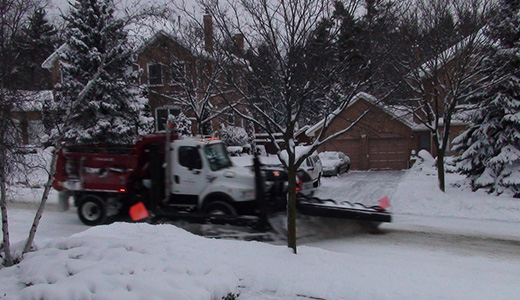
As a massive winter storm pounds the Midwest and Northeast with high winds, freezing rain, sleet and snow, budgets are straining to pay for snow removal, as public workers put in overtime plowing and salting streets.
The National Weather Service warns of a “dangerous, multifaceted and potentially life-threatening blizzard.” Officials have also warned of possible power outages. And many cities are still digging out from under the last snowstorm.
While cities and states typically budget ahead for winter snow removal, the frequency of storms so far this year – not worker salaries – has eaten away at many public works budgets.
Many states are already dealing with crushing budget deficits due to regressive tax policies, corporate tax loopholes and the recession.
The continuing tea party-Republican slash-and-burn “fiscal responsibility” and “deficit reduction” rhetoric demonstrates a blind unwillingness to develop an alternative plan to deal with local, state and federal budget shortfalls. Ironically, it is their “solution” that caused the budget crisis.
Let me explain.
In some circles it is being called the “blizzard narrative.” First, strangle the revenue base and cut budgets for vital social service departments. Second, control the narrative: “Tax cuts for the rich and layoffs aren’t the problem. It’s those overpaid public workers and their unions.” Third, use popular discontent and anger around service cuts to force pay reductions and break unions. Fourth, privatize vital services and turn them into unaccountable for-profit entities.
In fact, we’re seeing this tactic play out all across the country. Wisconsin’s new Republican governor recently bragged that he’s going to “force” state workers to take pay and benefit cuts. New York’s new Democratic governor just announced pay freezes for state workers. In Missouri, right-wing Republicans want “a culture of change” for social services and public workers. John Boehner, the new speaker of the House, is calling for austerity when it comes to public workers and the services they provide. There are many other examples. Throughout the country public workers are under attack.
The tea party-Republican mantra is “cut, cut, cut.” Public sector workers and the services they provide – services that every day benefit ordinary working class folks – are being sacrificed at the altar of so-called fiscal responsibility and cutting deficits.
Obviously, increasing taxes on the rich and corporations is out of the question for the Republicans and tea partiers. According to this logic, public sector workers and the communities they service must carry the weight of the crisis, a crisis they didn’t create.
Put simply, the tea party/right-wing Republican prescription for our ailing economy, crumbling infrastructure and decline in overall social service capacity is to blame public workers and their unions.
The narrative is pretty simple: Union workers are paid too much and have overly generous benefits packages; to reign in the budget deficit we must cut social services and public worker salaries, while cutting taxes on the rich and corporations; Wall Street will stimulate job growth and investment. In the meantime however, communities will just have to suffer without – without plowed streets, without salt trucks, without electricity and heat (due to power outages), without water (due to cracked water mains), and so on.
However, this right-wing free-market myth machine ignores the facts.
According to their anti-union, anti-public-sector logic we should be in the midst of a great economic boom, as union membership has declined dramatically over the past 30 years.
The Department of Labor reports overall union membership in 2010 was around 14.7 million, or 11.9 percent of the workforce, down 612,000 from 2009.
Public sector unions represented 7.6 million workers in 2010, down from 7.9 million in 2009. Public sector unions represent teachers, police officers, firefighters and social service workers, among others. Unionized public workers are about 36 percent of the public sector workforce.
Private sector unions represented 7.1 million workers in 2010, down from 7.4 million in 2009. Private sector unions represented about 25 percent to 30 percent of the workforce in the early 1980s; now they represent only 6.9 percent of the workforce.
So before we hastily blame unionized public sector workers for the mess we’re in, let’s ask ourselves: Has the sharp decline in private sector unionization over the past 30 years resulted in more jobs, higher wages and better services in the private sector? No! Then why should we expect slashing public sector unions to produce more jobs or better services?
Photo: Stradablog CC 2.0

MOST POPULAR TODAY

Zionist organizations leading campaign to stop ceasefire resolutions in D.C. area

High Court essentially bans demonstrations, freedom of assembly in Deep South

Communist Karol Cariola elected president of Chile’s legislature

U.S. imperialism’s ‘ironclad’ support for Israel increases fascist danger at home







Comments